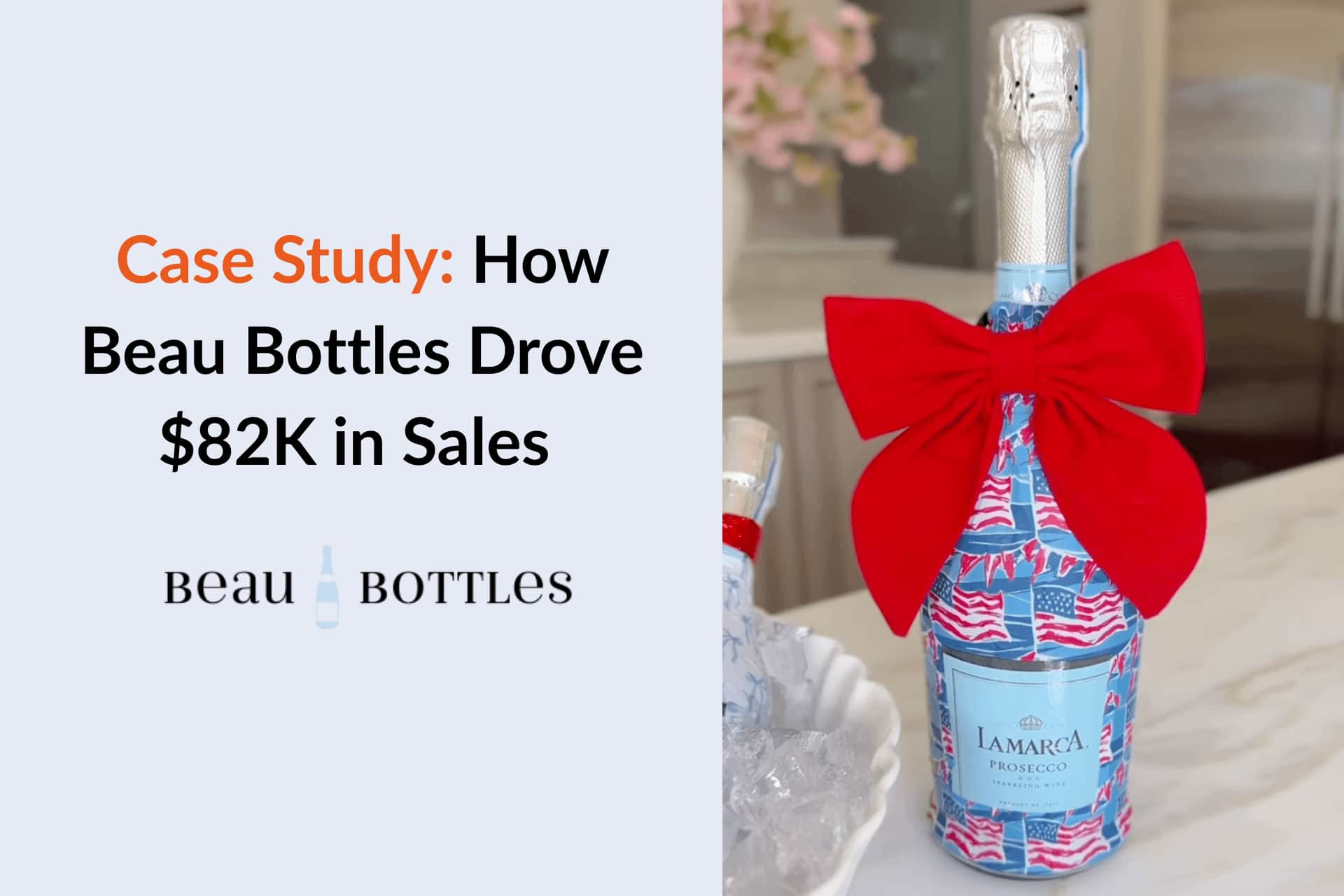





When it comes to influencer marketing platforms, Nindo has built a strong name in Europe, especially for its social media monitoring and influencer tracking capabilities. However, many users on forums and review sites point out significant downsides that push them to look for alternatives.
The most common complaints include limited influencer discovery outside the German-speaking market, lack of advanced campaign management features like outreach automation and CRM, and inflexible pricing that doesn’t scale well for growing brands.
In this article, we’ll explore the Top 10 Nindo Alternatives to help you find the right fit for your business:
When evaluating Nindo as an influencer marketing platform, many users recognize its strengths but also encounter limitations that lead them to consider alternative solutions. Based on user feedback and reviews on platforms such as Reddit and G2, four recurring pain points stand out:
Nindo is well-regarded for its reliable insights in the German-speaking market, yet this geographic focus can restrict scalability for brands aiming to run influencer campaigns across multiple international regions.
While the platform excels in discovery, channel analytics, charts, and fraud detection, it lacks integrated outreach, contracting, and payment features. This forces many organizations to rely on additional tools to manage the full influencer lifecycle.
Instead of transparent pricing tiers, Nindo offers only demo requests and a 7-day trial, which can complicate cost evaluation and prolong the decision-making process for small and medium-sized enterprises.
Nindo’s coverage is largely centered on Instagram, TikTok, YouTube, and Twitch, leaving gaps for teams that also require comprehensive support for X/Twitter, Facebook, Pinterest, or Snapchat.
Our comparison focuses on several key aspects:
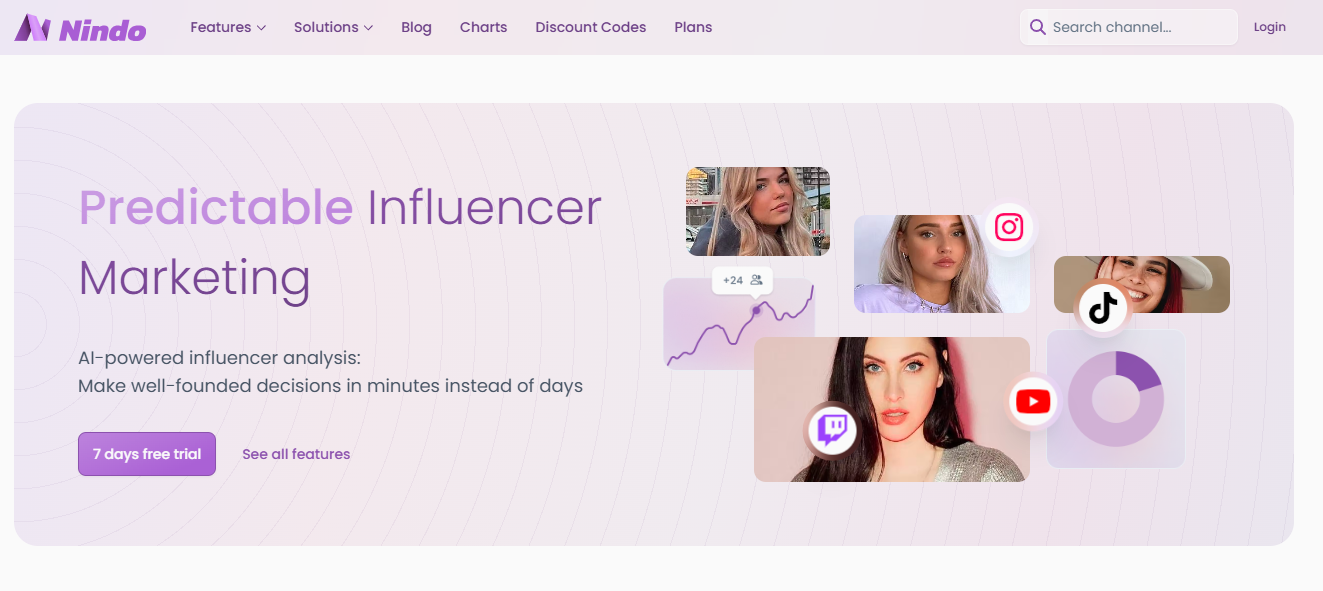
Best For: Nindo is best suited for brands and agencies focused on the German-speaking (DACH) market that need highly detailed analytics, influencer authenticity checks, and brand safety insights. It is particularly valuable for organizations that prioritize data precision and compliance.
Platform Coverage:
Pricing: Nindo offers three main different plans:
All plans have custom pricing upon request. Based on our research there’s a 7 day free trial and pricing typically starts at €600/month, but exact costs require a quote.
Reviews: No verified public reviews available on major platforms such as G2, Capterra, or Trustpilot.
Ease of Use (UX/UI): Users describe the platform as clean and modern, with intuitive dashboards and visualizations that make influencer data easy to digest. Nindo offers free trials and custom onboarding, making it easier for brands to evaluate usability before committing. Its localized interface is especially optimized for German-speaking markets.
Customer Support: Customer support includes onboarding and online help, although details on global response times remain limited. Brands in the DACH region report stronger experiences, as the company provides localized assistance and GDPR-compliant infrastructure.

Best For: Influencer Hero is best for eCommerce brands and D2C companies looking to scale influencer and affiliate campaigns with automation, advanced analytics, and deep CRM capabilities. It’s particularly strong for brands on Shopify, WooCommerce, and custom platforms that want a full end-to-end solution.
Platform Coverage:
Pricing: Influencer Hero offers flexible pricing plans to accommodate growing brands. All plans include core features and can scale as the influencer program grows.
Reviews: 5.0 / 5.0 (Capterra)
Ease of Use (UX/UI): Known for its intuitive interface, Influencer Hero offers a clean, streamlined dashboard that simplifies campaign management. Automated workflows, customizable email templates, and a Chrome extension make it easy for teams to save hours each week. Users praise how quickly new members can onboard without training.
Customer Support: Customer support is one of Influencer Hero’s strongest assets, offering 24/7 real-human live chat, responsive email support, and a comprehensive Help Center with both written and video tutorials. Every plan includes a dedicated account manager from day one, with Pro users also getting access to a private Slack channel for ongoing, faster support. Optional strategy consultations further guide brands toward growth.
Nindo positions itself as a German-focused influencer analytics platform, offering detailed insights, fake follower detection, and brand safety checks. However, its pricing starts around €600/month with limited transparency, and reviews highlight its regional bias toward DACH markets.
In contrast, Influencer Hero provides a truly global, all-in-one influencer marketing suite that covers everything from discovery and outreach to UGC collection, affiliate tracking, and storefront management. With flexible plans starting at $649/month and scaling up to enterprise-level, brands get far more than analytics—they gain automation, multi-platform integrations, and end-to-end campaign execution.
For brands deciding between the two, Nindo is better suited for companies targeting German-speaking markets needing strong data accuracy. But for scalable, international campaigns with deeper automation and eCommerce integrations, Influencer Hero is the superior choice.
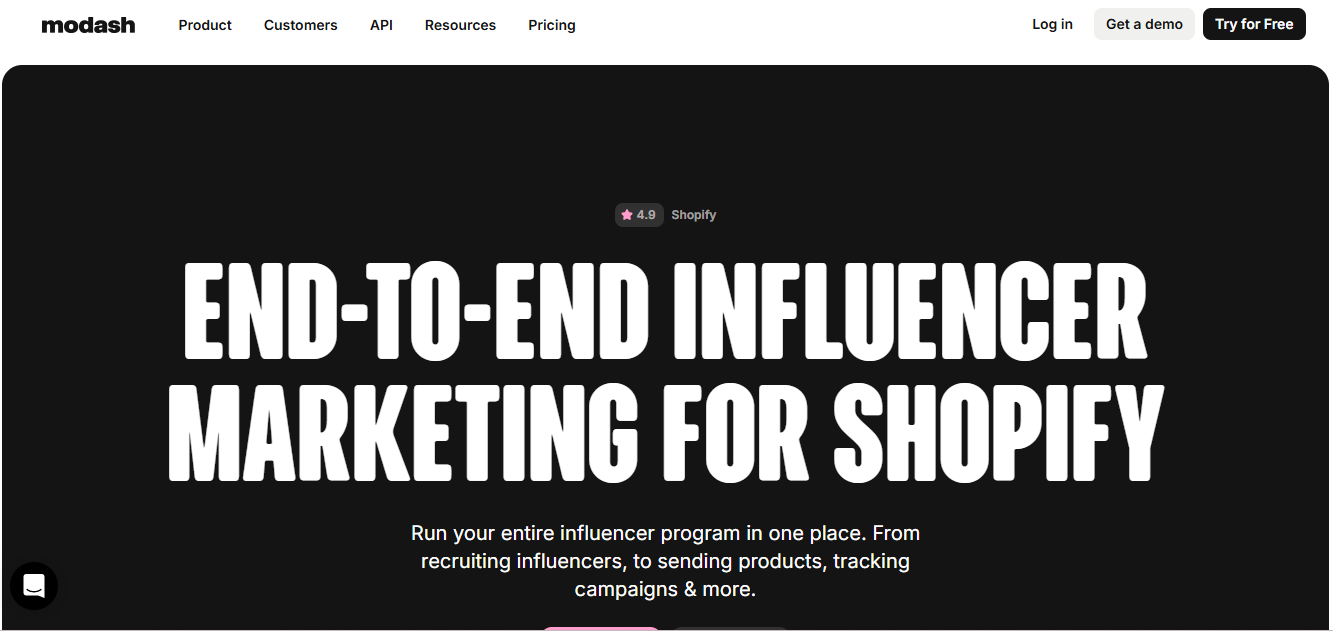
Best For: Modash is best for eCommerce and DTC brands that want to streamline influencer discovery, outreach, and affiliate campaign tracking in one place. It’s particularly effective for brands on Shopify looking to scale influencer partnerships with gifting, discount codes, and automated payouts.
Platform Coverage:
Pricing: There are different plans and options.
Reviews: 4.7/5 (G2)
Ease of Use (UX/UI): Users highlight Modash’s clean and straightforward dashboard, with intuitive filters that make it easy to discover and evaluate influencers at scale. The AI-powered search and audience breakdowns simplify narrowing down creators by niche, location, or demographics, making the platform accessible even to first-time users.
Customer Support: Modash is praised for excellent onboarding and responsive support. Customers value the dedicated account management, where the team provides guidance on campaign setup, gifting flows, and affiliate automation. While support is available via email and onboarding calls, the platform is also improving its help center and documentation for self-service users.
Nindo is best for brands in the German-speaking (DACH) market that prioritize detailed analytics, brand safety, and historical data insights. Its pricing starts at around €600/month, but exact plans are quote-based and less transparent.
On the other hand, Modash takes a more global approach, offering access to 350M+ creator profiles across Instagram, TikTok, and YouTube. Its standout strength lies in Shopify-native integrations, allowing brands to automate gifting, affiliate links, and payouts seamlessly. Pricing is also more accessible, starting at $199/month for Essentials and $499/month for the Performance plan.
For smaller or mid-sized eCommerce brands, Modash provides a more cost-effective and automation-friendly solution, whereas Nindo is better suited for larger enterprises or agencies that value precision, data integrity, and brand safety over workflow automation.

Best For: Upfluence is best for eCommerce brands, especially those on Shopify and Amazon, that want to run data-driven influencer campaigns, track ROI from affiliate sales, and manage everything from discovery to payouts in one platform.
Platform Coverage:
Pricing:
Reviews: 4.5/5 (G2)
Ease of Use (UX/UI): Users describe Upfluence as a robust and feature-rich tool with advanced search and filtering capabilities, but note there is a learning curve for beginners given the platform’s depth. Once set up, the workflow between influencer search, outreach, and tracking is streamlined, which many brands find effective for scaling campaigns.
Customer Support: Customers highlight that support is professional and responsive, though some note that direct assistance can be slower compared to competitors unless you’re on higher-tier plans. The onboarding team is reported to be helpful in navigating the platform’s complex setup, especially for larger brands.
Nindo positions itself as a data-driven analytics platform with a strong focus on the German-speaking market, offering precise demographic analysis, fake follower detection, and brand safety tools. In contrast, Upfluence is designed for global eCommerce brands and stands out with Shopify and Amazon integrations, making it far more ROI-oriented for sellers.
Pricing is another key differentiator: Nindo starts at around €600/month (though actual pricing is not fully transparent), while Upfluence charges $1,276/month with annual contracts. While Upfluence is costlier, it offers an end-to-end solution covering influencer discovery, outreach, campaign management, and payments, whereas Nindo primarily excels in analytics and regional coverage.
In short, brands focused on deep analytics in the DACH market might prefer Nindo, while those running large-scale eCommerce influencer campaigns across global markets will likely find Upfluence’s integrations and all-in-one functionality a stronger choice.

Best For: Captiv8 is best for large enterprises and global brands that need advanced campaign tracking, competitive intelligence, and enterprise-level influencer marketing solutions with deep analytics. Its pricing structure and feature set are primarily designed for established companies with significant marketing budgets.
Platform Coverage:
Pricing: There are different pricing options:
Reviews: 4.1/5 (G2)
Ease of Use (UX/UI): Users describe Captiv8’s interface as feature-rich but complex, with many advanced filters and reporting tools that require time to learn. The dashboard offers granular customization, like drag-and-drop metrics and filter locking, which are powerful but may feel overwhelming for smaller teams or beginners. Overall, it’s well-suited for seasoned marketing teams that want control over every detail.
Customer Support: Captiv8’s customer support has received mixed reviews. While enterprise clients may benefit from dedicated account management, many smaller brands and creators report slow or unresponsive support and unresolved issues related to account or payment management.
Nindo is particularly strong in the German and DACH markets, offering precise analytics, fake follower detection, and brand safety features at a starting benchmark of €600/month. This makes it a relatively affordable option for mid-sized brands seeking accuracy and trust in influencer data.
Captiv8, on the other hand, is tailored for enterprise-level clients with global campaign needs. Its pricing starts at $25,000 annually, plus onboarding fees and optional add-ons costing up to $30K/month, which makes it inaccessible to smaller businesses. While it offers advanced tracking, sentiment analysis, and storefront integrations, the steep costs and enterprise orientation limit its audience.
For brands in the DACH region or mid-market level, Nindo presents a cost-effective, accurate solution. For large enterprises with global campaigns, Captiv8 provides unmatched campaign tracking and competitive intelligence, though at a significant investment.

Best For: CreatorIQ is best for enterprise and mid-to-large brands that want an end-to-end influencer marketing solution covering discovery, campaign management, payments, and advanced reporting. It’s particularly strong for brands that value data accuracy, compliance, and deep integrations with major social platforms.
Platform Coverage:
Pricing: There are different plans:
Reviews: 4.7/5 (G2)
Ease of Use (UX/UI): Users describe CreatorIQ’s interface as feature-rich but complex, meaning it can feel overwhelming at first for smaller teams. However, once onboarded, the workflows are efficient and the customizable dashboards make navigation straightforward. The platform’s campaign sheets, live reporting links, and centralized CRM help reduce manual work.
Customer Support: Customers highlight CreatorIQ’s dedicated implementation managers and customer success teams, who provide hands-on help during onboarding and ongoing campaigns. Many users also appreciate the strategic guidance and quarterly planning support, noting that it’s more than just software — it’s a true partnership.
CreatorIQ is a premium, enterprise-grade platform, designed for large brands and agencies with budgets typically starting around $2K–$5K per month, while Nindo is a more affordable, analytics-first tool that emphasizes data insights and influencer search at a lower entry price.
If you’re a brand that needs advanced campaign management, CRM, payment processing, and direct API integrations with platforms like Meta and TikTok, CreatorIQ is the stronger choice. However, if your main focus is competitor analysis, influencer tracking, and affordability, Nindo offers excellent value without the heavy annual contract commitment.
In short: Choose CreatorIQ if you need an all-in-one solution with enterprise support and compliance. Choose Nindo if you’re budget-conscious and want streamlined influencer discovery and analytics.

Best For: HypeAuditor is best for brands and agencies that want data-driven influencer discovery and fraud detection, especially those running cross-platform campaigns across Instagram, TikTok, YouTube, Twitch, X, and Snapchat.
Platform Coverage:
Pricing: HypeAuditor’s pricing is customizable, with the standard “Business” plan starting at around $10,000/year. Pricing can be adjusted based on the number of reports, active campaigns, and platform usage. They also offer a 24–48 hour free trial for new users.
Reviews: 4.6/5 (G2)
Ease of Use (UX/UI): Users describe HypeAuditor as a powerful but somewhat complex platform. Its wide set of filters, AI search, and campaign tools are very detailed, which is great for professionals but may require onboarding for beginners. Reports and dashboards are customizable and exportable, though some users find the learning curve higher compared to simpler tools.
Customer Support: Customer support includes onboarding and training sessions, which are often necessary given the platform’s depth. Users report that the team is responsive and helps with campaign setup, but some note that support feels more enterprise-oriented rather than tailored to smaller brands.
While HypeAuditor positions itself as a global, data-heavy platform with AI discovery, fraud detection, and customizable pricing (starting around $10K/year), Nindo focuses more on the German and DACH markets, providing highly accurate local data, historical analytics, and brand safety checks.
For brands targeting German-speaking audiences, Nindo’s regional depth and reliability may be more valuable. However, its pricing (~€600/month) can still be steep for smaller companies. On the other hand, HypeAuditor’s broad platform coverage and advanced AI tools make it better suited for international campaigns with larger budgets.
In short, choose Nindo if you need precision and trust in the German/DACH market, but go with HypeAuditor if you’re running larger, global campaigns and can justify the higher cost.

Best For: GRIN is best for DTC and eCommerce brands looking for an end-to-end influencer marketing platform that integrates deeply with Shopify, WooCommerce, and other commerce systems. It’s especially effective for brands with larger catalogs that want to automate gifting, discount codes, affiliate tracking, and UGC management in one place.
Platform Coverage:
Pricing:
Reviews: 4.5 / 5.0 (G2)
Ease of Use (UX/UI): Users often highlight GRIN’s all-in-one workflow as a big advantage since everything—outreach, gifting, payments, UGC collection—lives in a centralized dashboard. However, some note that the creator search tools can be inconsistent, with duplicates or irrelevant results showing up. While the UI is feature-rich, performance issues like slow loading or glitches have been reported, which occasionally disrupts campaign execution.
Customer Support: GRIN provides dedicated account managers and optional program strategists, which many users find helpful for onboarding and campaign optimization. That said, support experiences are mixed: while some users report responsive and knowledgeable assistance, others mention delays or unresolved tickets, sometimes even being billed for features that weren’t working properly.
Nindo is primarily an analytics and discovery tool, offering detailed demographic insights, bot detection, and historical collaboration data, with a strong focus on the German/DACH market. It starts around €600/month, making it more accessible for smaller or mid-sized brands.
In contrast, GRIN is an end-to-end influencer management system with eCommerce-native features like product seeding, discount codes, integrated payments, and affiliate tracking. However, its $25,000/year entry price makes it a heavy investment, better suited for larger DTC brands with established influencer programs.
In short, brands seeking precise analytics and market-specific insights will find Nindo a strong fit, while those looking for a comprehensive, eCommerce-driven influencer workflow will benefit more from GRIN—if their budget allows.
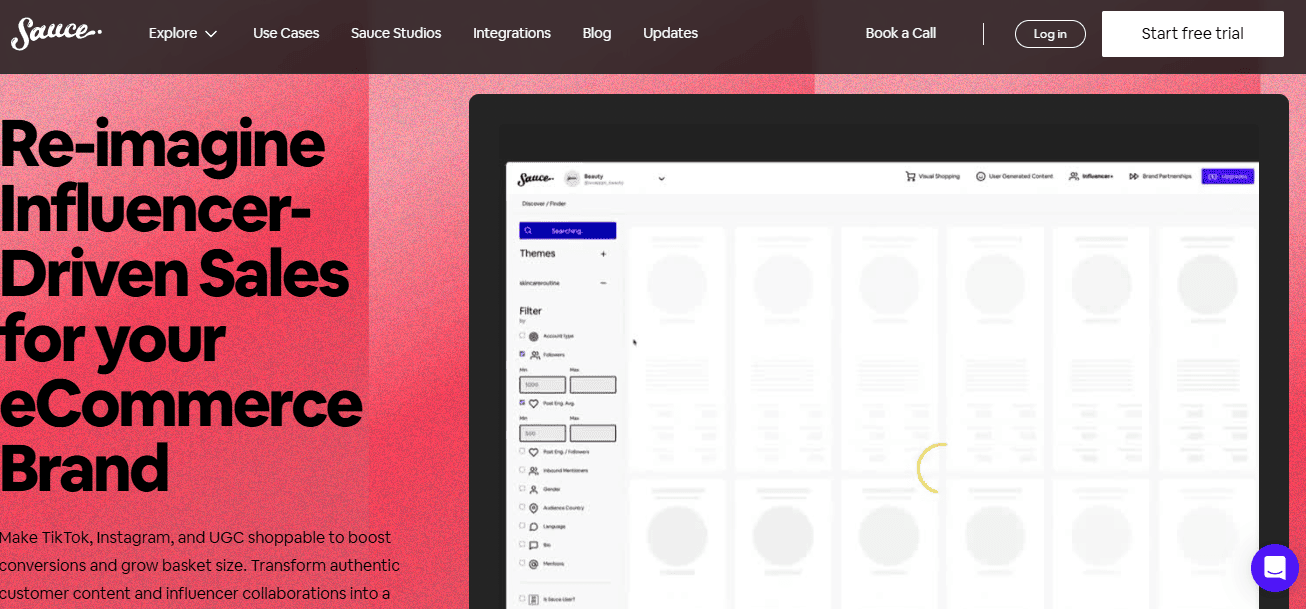
Best For: Sauce is best for eCommerce brands on Shopify, TikTok, and Instagram that want to transform influencer and customer content into shoppable UGC experiences and boost conversions through social commerce.
Platform Coverage:
Pricing: Based on our research, Sauce offers different plans. All plans include a 7-day free trial with the option to switch or cancel anytime.
Reviews: 4.6 / 5.0 (G2)
Ease of Use (UX/UI): Users highlight Sauce’s visual-first interface and zero-code setup, making it quick to implement. Embedding shoppable galleries or video content into sites and emails takes just a few clicks, with merchants praising the intuitive design and fast load times.
Customer Support: Customer reviews frequently mention Sauce’s responsive support team and live chat availability. The inclusion of a free trial and onboarding assistance makes the tool approachable, while brands value having quick solutions during campaign setup.
Nindo positions itself as a robust influencer discovery and analytics tool, offering detailed performance insights across Instagram, TikTok, and YouTube, with a strong focus on data-driven campaign planning. Sauce, on the other hand, emphasizes shoppable UGC and influencer content, turning social media engagement into measurable revenue through visual shopping galleries and video commerce.
When it comes to pricing, Sauce offers a tiered model starting at $50/month, scaling up to $600/month with enterprise options at $2,000+, tied directly to impressions and attributed sales. Nindo pricing is less publicly transparent but tends to be positioned for mid-to-large scale influencer campaigns, often on the higher side. This makes Sauce more appealing for smaller eCommerce brands looking for entry-level affordability, while Nindo is better suited for companies prioritizing in-depth influencer analytics and data coverage.
In short, choose Nindo if your priority is comprehensive influencer insights and campaign tracking, but opt for Sauce if your goal is to directly monetize influencer and UGC content into shoppable experiences with scalable pricing.
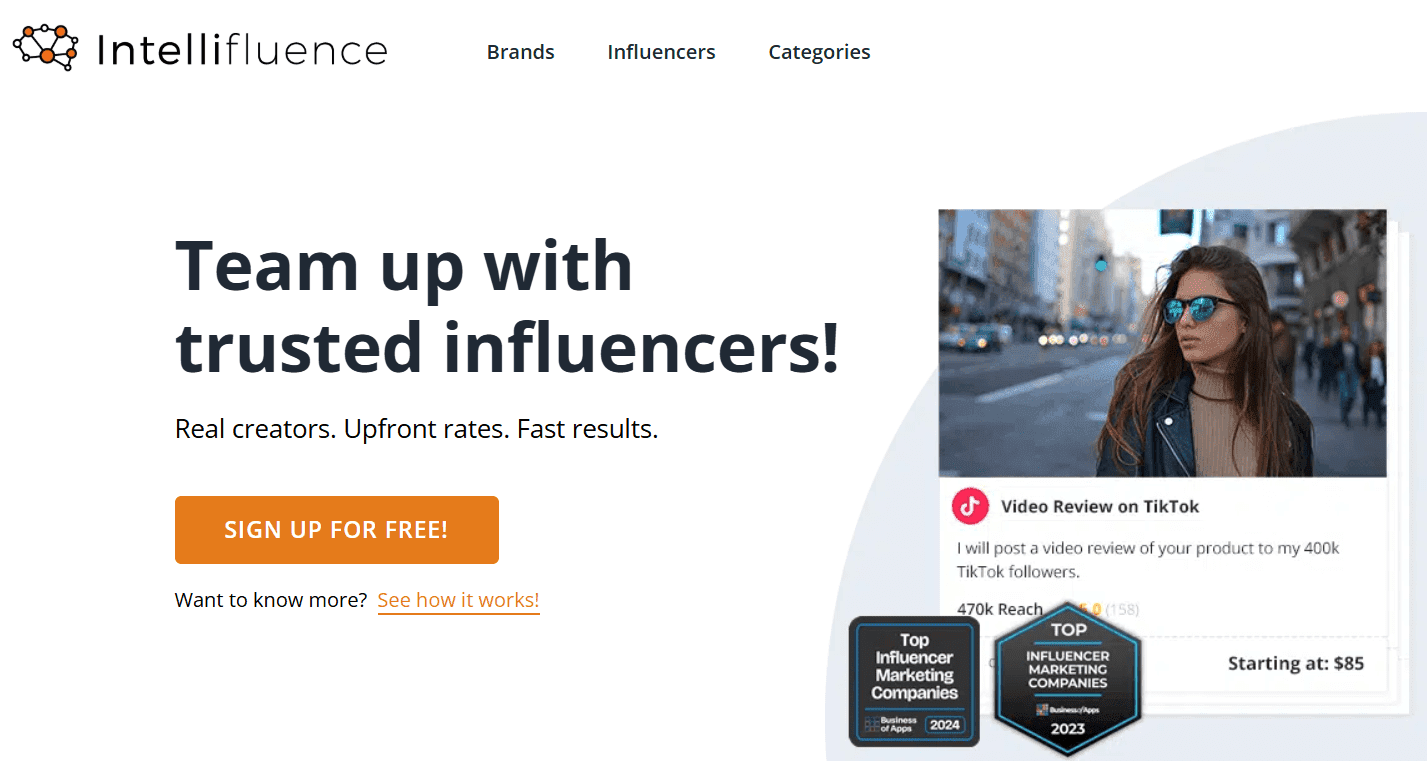
Best For: Intellifluence is best for small to medium-sized brands looking for affordable, flexible influencer marketing without long-term commitments. It’s especially useful for those aiming to collaborate with micro- and nano-influencers, generate UGC, or run multi-platform campaigns across blogs, podcasts, TikTok, Instagram, YouTube, and more.
Platform Coverage:
Pricing: Based on our research, there are different options and pricings:
Reviews: 3.9/5.0 (G2).
Ease of Use (UX/UI): Users generally find Intellifluence intuitive, with a clean dashboard and straightforward workflows for campaign management and influencer communication. The learning curve is minimal, and the built-in Influencer Offers marketplace simplifies collaboration. Some users, however, note that the mobile experience isn’t as smooth as the web version, and occasional bugs can slow down workflows.
Customer Support: The platform’s customer support receives praise for being responsive and beginner-friendly, with tutorials and resources that help new users. Many report positive interactions with the support team when resolving issues. However, some reviews mention that campaign approvals and dispute resolution can be slow, especially during high activity periods.
Nindo is positioned as a premium analytics-driven platform (starting at around €600/month), focusing heavily on data accuracy, brand safety, and historical performance insights. This makes it a better fit for larger brands or agencies that need deep analytics and risk detection.
Intellifluence, on the other hand, is far more affordable and accessible, starting with a free plan and scaling up to $599/month. It is designed for smaller brands and startups that want flexibility and direct access to a wide pool of opt-in influencers. However, it lacks the same depth of analytics and fraud detection tools that Nindo provides.
In short, if you’re looking for data precision, brand safety, and historical insights, Nindo is the stronger choice. But if you prioritize budget flexibility, access to a large opt-in influencer network, and low barriers to entry, Intellifluence is the better option.
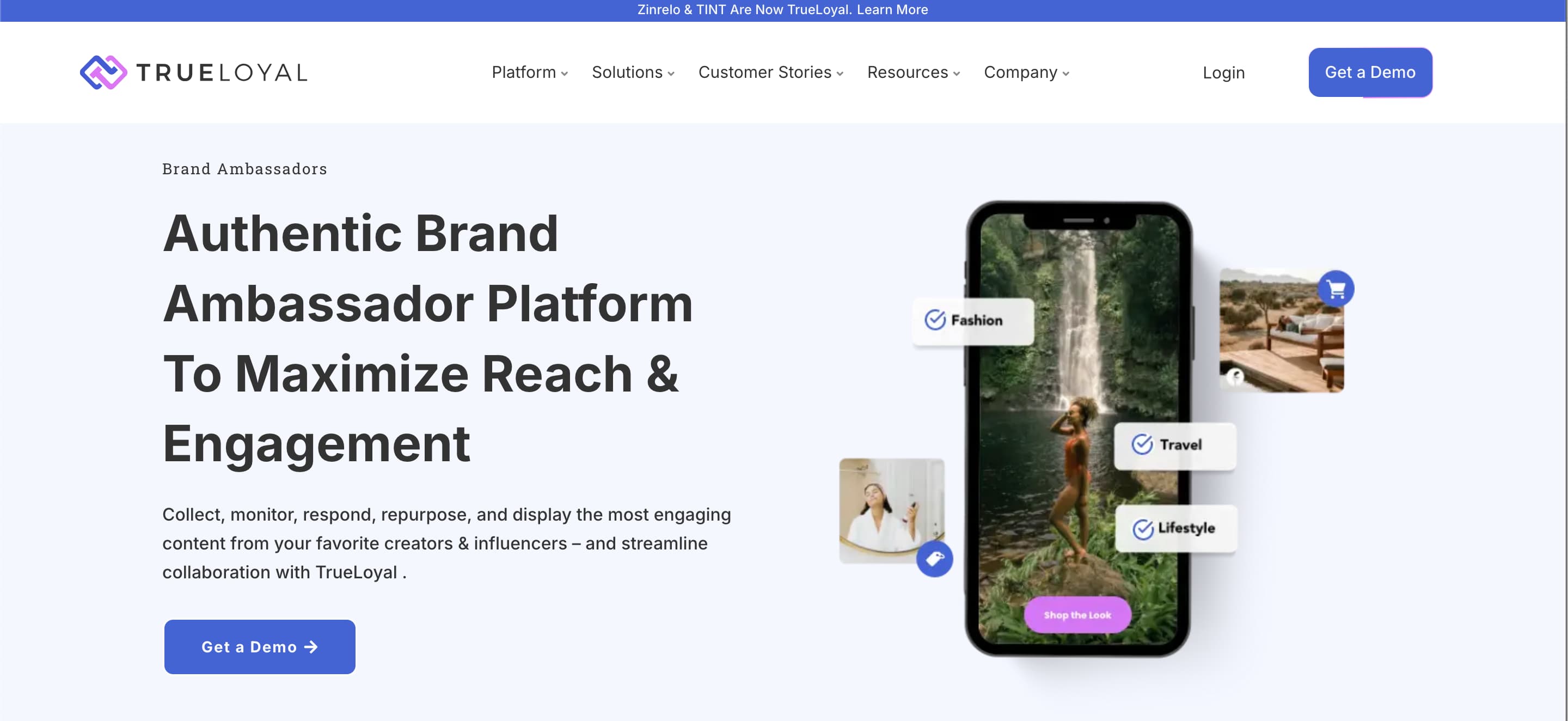
Best For: TrueLoyal is best for brands looking to turn their existing customers, creators, and influencers into authentic brand ambassadors. It’s particularly effective for eCommerce companies that want to centralize UGC, influencer content, and customer advocacy into one platform to drive conversions.
Platform Coverage:
Pricing: Undisclosed.
Reviews: 4.3 / 5.0 (G2)
Ease of Use (UX/UI): Users highlight that TrueLoyal’s interface is straightforward and intuitive, making it easy to send briefs, collect content, and activate assets across different channels. The workflow feels centralized, which helps teams avoid scattered tools and messy manual processes.
Customer Support: Feedback suggests TrueLoyal offers responsive support during onboarding and campaign execution. Brands value the strategist guidance the platform provides, especially for discovering aligned creators and setting up effective advocacy programs.
Nindo is a data-driven analytics and influencer discovery platform priced at around €600/month, making it attractive to brands that prioritize deep performance insights, fraud detection, and precise campaign analytics, particularly in the German and European markets.
TrueLoyal, by contrast, is designed as a brand ambassador and UGC activation platform. Instead of focusing on broad influencer discovery, it helps brands leverage existing fans, customers, and creators to generate authentic content and repurpose it across eCommerce pages, campaigns, and product launches.
For brands that need robust analytics, competitor analysis, and fraud detection, Nindo offers more value. But for those who want to maximize authentic UGC, streamline rights management, and directly integrate content into eCommerce platforms, TrueLoyal is the better choice. The decision ultimately comes down to whether you prioritize influencer data depth (Nindo) or authentic content activation (TrueLoyal).
Exploring Nindo alternatives reveals that while Nindo excels in data-driven analytics, fraud detection, and performance tracking, many platforms offer additional strengths that may better fit specific brand needs. From tools focusing on influencer discovery, AI-powered outreach, and streamlined campaign management to solutions centered on UGC rights management and eCommerce integrations, brands have a wide variety of options depending on their goals and budgets.
Among these options, Influencer Hero stands out as one of the best all-in-one alternatives, combining influencer search, outreach, affiliate tracking, CRM, and analytics in a single platform. It’s a great choice if you’re looking to simplify your influencer marketing workflow and drive measurable ROI.
Ready to see it in action? Book a demo with Influencer Hero today and discover how it can transform your influencer campaigns.

Nindo is known for its deep analytics, influencer performance tracking, and fraud detection, especially popular in the German and European markets.
Alternatives may offer better influencer discovery, CRM tools, AI-powered outreach, or eCommerce integrations, which Nindo doesn’t fully provide.
Yes, Influencer Hero is considered one of the best all-in-one alternatives, offering influencer discovery, affiliate tracking, outreach, and advanced analytics in one platform.
Platforms like Intellifluence or Sauce can be cost-effective for small businesses, while Influencer Hero provides scalable options for both small and large brands.
It depends on your priorities—choose Nindo if you need analytics depth, or go with an alternative like Influencer Hero if you want a complete workflow solution for influencer marketing and affiliate campaigns.



Schedule a Demo with one of our media experts below.